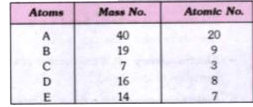State the nature of compounds formed when group 17 elements combine with (i) metals (ii) non-metals.
To answer the question about the nature of compounds formed when group 17 elements (halogens) combine with metals and non-metals, we can break it down into two parts:
Step 1: Compounds formed with Metals
1. Identify Group 17 Elements: The elements in group 17 are known as halogens, which include Fluorine (F), Chlorine (Cl), Bromine (Br), Iodine (I), and Astatine (At).
2. Nature of Bond with Metals: When halogens combine with metals, they tend to form ionic compounds.
3. Example of Ionic Compounds: For instance, when sodium (Na) combines with chlorine (Cl), it forms sodium chloride (NaCl). In this reaction, sodium loses one electron, and chlorine gains one electron, resulting in the formation of an ionic bond.
4. Conclusion for Metals: Therefore, the nature of compounds formed when group 17 elements combine with metals is ionic.
Step 2: Compounds formed with Non-Metals
1. Nature of Bond with Non-Metals: When halogens combine with non-metals, they typically form covalent compounds.
2. Example of Covalent Compounds: For example, when chlorine (Cl) combines with hydrogen (H), it forms hydrogen chloride (HCl). In this case, the bond formed is covalent, as both elements share electrons.
3. Additional Examples: Other examples of covalent compounds formed by halogens with non-metals include sulfur tetrafluoride (SF4), sulfur hexafluoride (SF6), and carbon tetrachloride (CCl4).
4. Conclusion for Non-Metals: Thus, the nature of compounds formed when group 17 elements combine with non-metals is covalent.
Final Answer:
- When group 17 elements (halogens) combine with metals, they form ionic compounds.
- When they combine with non-metals, they form covalent compounds.
---
1. Identify Group 17 Elements: The elements in group 17 are known as halogens, which include Fluorine (F), Chlorine (Cl), Bromine (Br), Iodine (I), and Astatine (At).
2. Nature of Bond with Metals: When halogens combine with metals, they tend to form ionic compounds.
3. Example of Ionic Compounds: For instance, when sodium (Na) combines with chlorine (Cl), it forms sodium chloride (NaCl). In this reaction, sodium loses one electron, and chlorine gains one electron, resulting in the formation of an ionic bond.
4. Conclusion for Metals: Therefore, the nature of compounds formed when group 17 elements combine with metals is ionic.
1. Nature of Bond with Non-Metals: When halogens combine with non-metals, they typically form covalent compounds.
2. Example of Covalent Compounds: For example, when chlorine (Cl) combines with hydrogen (H), it forms hydrogen chloride (HCl). In this case, the bond formed is covalent, as both elements share electrons.
3. Additional Examples: Other examples of covalent compounds formed by halogens with non-metals include sulfur tetrafluoride (SF4), sulfur hexafluoride (SF6), and carbon tetrachloride (CCl4).
4. Conclusion for Non-Metals: Thus, the nature of compounds formed when group 17 elements combine with non-metals is covalent.
- When group 17 elements (halogens) combine with metals, they form ionic compounds.
- When they combine with non-metals, they form covalent compounds.
Topper's Solved these Questions
- THE PERIODIC TABLE BOOK - ICSECHAPTER - THE PERIODIC TABLE EXERCISE - TOPIC 1 Modern Periodic Table and its Periodicity (1 Mark Questions )
25 Videos
- THE PERIODIC TABLE BOOK - ICSECHAPTER - THE PERIODIC TABLE EXERCISE - TOPIC 1 Modern Periodic Table and its Periodicity (2 Marks Questions )
50 Videos
- THE PERIODIC TABLE BOOK - ICSECHAPTER - THE PERIODIC TABLE EXERCISE - TOPIC 2 Studying Individual Groups (5 Marks Questions)
34 Videos
- THE LANGUAGE OF CHEMISTRYBOOK - ICSECHAPTER - THE LANGUAGE OF CHEMISTRYEXERCISE - EXCERCISE 1(C ) (Correct the following statement)
21 Videos
- WATERBOOK - ICSECHAPTER - WATEREXERCISE - TOPIC 2 Solution (5 MARKS QUESTIONS)
5 Videos
Similar Questions
State the nature of compounds formed when group 17 elements combine with non-metals
View SolutionWhat is nature of compounds formed when group 17 elements react with metals ?
View SolutionWhat type of oxides is formed when non-metals combine with oxygen?
View SolutionState the type of elements present in
group 17 [VIIA]
View SolutionStable compounds that are formed when metals react with non-metals
View SolutionElements showing properties of both metals and non-metals
View SolutionBased on the group valency of elements state the formula for the following giving justification for each :
(i) Oxides of 1st group elements,
(ii) Halides of the elements of group 13,
(iii) Compounds formed when an element of group 2 combines with an element of group 16.
View SolutionAmong the group 13 the only element which is non -metal
View SolutionFive atoms are labelled from A to E

Predict which are :
(i) metals ?
(ii) non-metals?
View SolutionWhich of the group 15 elelments are non-metallic ?
View Solution
